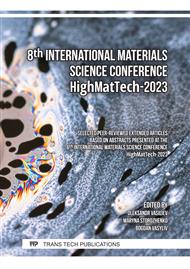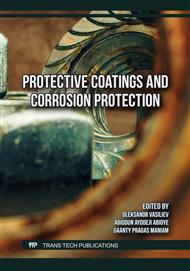[1]
Y. Liu, S. Yu, Q. Shi, X. Ge, W. Wang, Multilayer coatings for tribology: A mini review, Nanomaterials, 12, 9 (2022).
DOI: 10.3390/nano12091388
Google Scholar
[2]
A. Alamgir, M. Yashin, A. Bogatov, M. Viljus, R. Traksmaa, J. Sandor, A. Lumkemann, F. Sergejev, V. Podgursky, High-temperature tribological performance of hard multilayer TiN-AlTiN/AlCo-CrN/AlCrN –AlCrO-AlTiCrN coating deposited on WC-Co substrate, Coatings 10 (2020).
DOI: 10.3390/coatings10090909
Google Scholar
[3]
J. Brezinova, J. Hasul, J. Brezina, P. Marushchak, J. Vinas, Determination of tribological properties of multilayer coatings based on nitrides, Physical and chemical mechanics of materials 58, 5 (2022) 68–73.
DOI: 10.1007/s11003-023-00709-y
Google Scholar
[4]
S. Gupta, M.W. Barsoum, On the tribology of the MAX phases and their composites during dry sliding: A review, Wear 271 (2011) 1878–1894.
DOI: 10.1016/j.wear.2011.01.043
Google Scholar
[5]
S. Gupta, D. Filimonov, T. Palanisamy, M.W. Barsoum, Tribological behavior of select MAX phases against Al2O3 at elevated temperatures, Wear 265 (2008) 560–565.
DOI: 10.1016/j.wear.2007.11.018
Google Scholar
[6]
Sh. Wang, J. Ma, Sh. Zhu, J. Cheng, Zh. Qiao, J. Yang, W. Liu, High temperature tribological properties of Ti3AlC2 ceramics against SiC under different atmospheres, Mater. and Des. 67 (2015) 188–196.
DOI: 10.1016/j.matdes.2014.11.043
Google Scholar
[7]
C. Magnus, Sliding wear of MAX phase composites Ti3SiC2-TiC and Ti3AlC2-Ti2AlC at 400°C and the influence of counterface material (steel, Al2O3 and Si3N4) on wear behavior, Wear (2022).
DOI: 10.1016/j.wear.2022.204588
Google Scholar
[8]
Y. Xue, Ch. Wang, Q. Zeng, J. Wang, H. Jing, Z. Wang, Ch.-F. Du, Ordered metal substitution in Ti3AlC2 and the effect on tribological behaviors in a wide temperature range, Tribol. International 178A (2023).
DOI: 10.1016/j.triboint.2022.108009
Google Scholar
[9]
O. Wihelmason, M. Rasander, M. Carllsob et al., Design of nanocomposite low-friction coatings, Adv. Funct. Mater. 17 (2007) 1611–1616.
DOI: 10.1002/adfm.200600724
Google Scholar
[10]
P. Eklund, M. Beckers, U. Jansson, H. Hogberg, L. Hultman, The Mn+1AXn phases: Materials science and thin-film processing, Thin Solid Films 518 (2010) 1851–1878.
DOI: 10.1016/j.tsf.2009.07.184
Google Scholar
[11]
M. Hopfeld, R. Grieseler, A. Vogel, H. Romanus, P. Schaaf, Tribological behavior of selected Mn+1AXn phases thin films on silicon substrates, Surf. and Coat. Technol. 257 (2014) 286–294.
DOI: 10.1016/j.surfcoat.2014.08.034
Google Scholar
[12]
J.Q. Ma, F. Li, J. Cheng, L.C. Fu, Z.H. Qiao, W.M. Lie et al., Tribological behavior of Ti3AlC2 against SiC at ambient and elevated temperatures, Tribol. Lett. 50 (2013) 323–330.
DOI: 10.1111/j.1551-2916.2007.01950.x
Google Scholar
[13]
X.L. Shi, M. Wang, Z.S. Xu, W.Z. Zhai, Q.X. Zhang, Tribological behavior of Ti3AlC2/(WC-10Co) composites prepared by spark plasma sintering, Mater. Des. 45 (2013) 365–376.
DOI: 10.1016/j.matdes.2012.08.069
Google Scholar
[14]
Т.О. Prikhna, V.Ya. Podhurs'ka, О.P. Ostash, B.D. Vasyliv, et al., Influence of the Technology of Production of Composites Based on the MAX Phases of Titanium on the Process of Wear in Contact with Copper. Part 2. Single-Stage Technology, Mater. Sci. 55, 1 (2019) 1–8.
DOI: 10.1007/s11003-019-00244-9
Google Scholar
[15]
A.S. Kuprin, S.A. Leonov, V.D. Ovcharenko, E.N. Reshetnyak, et al., Deposition of TiN-based coatings using vacuum arc plasma in increased negative substrate bias voltage, Problems of Atomic Science and Technology 5, 123 (2019) 154–160.
DOI: 10.46813/2019-123-154
Google Scholar
[16]
W. Oliver, G. Pharr, Measurement of hardness and elastic modulus by instrumented indentation: Advances in understanding and refinements to methodology, J. Mater. Res. 19, 1 (2004) 3–20.
DOI: 10.1557/jmr.2004.19.1.3
Google Scholar
[17]
T. Kuznetsova, V. Lapitskaya, A. Khabarava, S. Chizhik, et al., Effect of Metallic or Non-Metallic Element Addition on Surface Topography and Mechanical Properties of CrN Coatings, Nanomaterials, 10(12), (2020) 2361.
DOI: 10.3390/nano10122361
Google Scholar
[18]
M.D. Hayat, H. Singh, Z. He, P. Cao, Titanium metal matrix composites: An overview, Composites Part A: Applied Science and Manufacturing, 121 (2019) 418–438.
DOI: 10.1016/j.compositesa.2019.04.005
Google Scholar



